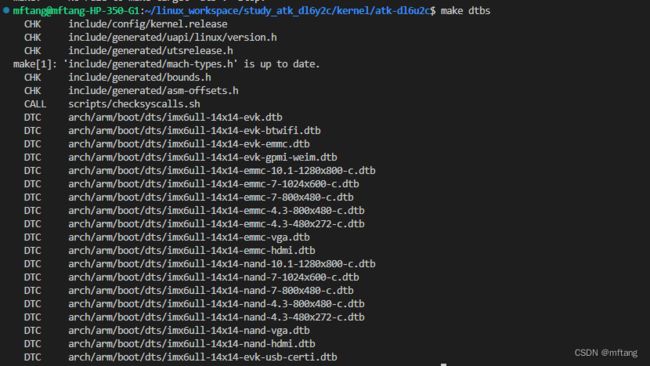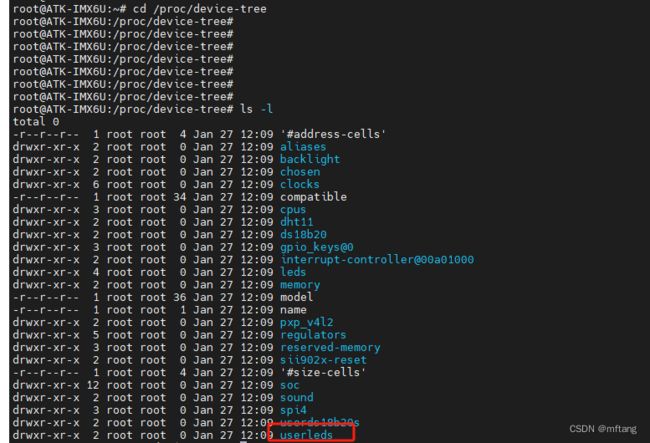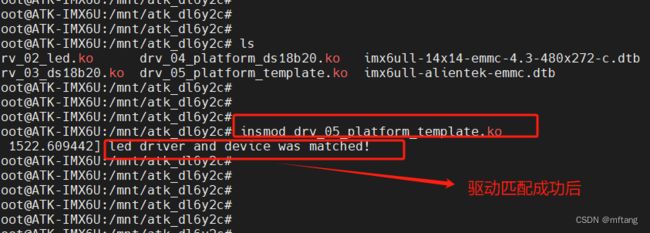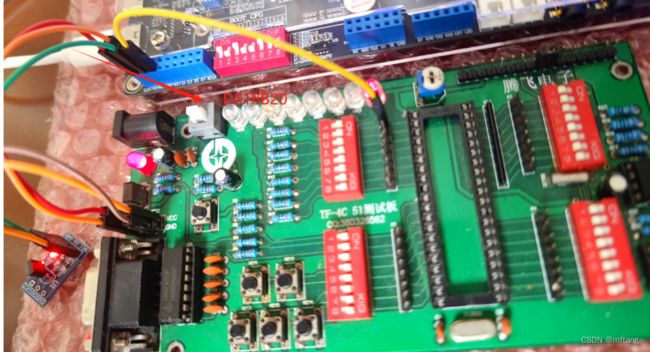一个设备树驱动程序Demo(linux)
目录
1 编写节点参数
2 编写驱动代码
3 编写测试程序
4 运行测试
系统环境:
使用Linux内核: linux-imx-4.1.15-2.1.0-g3dc0a4b-v2.7.tar.bz2
硬件:正点原子ATK-DL6Y2C开发板
内核启动位置:eMMC
platform 驱动框架分为总线、设备和驱动,其中总线不需要我们这些驱动程序员去管理,这个是 Linux 内核提供的,在编写驱动的时候只要关注于设备和驱动的具体实现即可。在使用设备树架构,设备的描述被放到了设备树中,因此 platform_device 就不需要去编写了,只需要实现 platform_driver 即可。
下面实现一个基于platfrom架构的程序,其具体方法如下:
1 编写节点参数
在imx6ull-14x14-evk.dts中编写节点参数,参数内容包括:IO-PIN引脚,状态信息等,具体代码如下:
//mftang: user's led, 2024-1-26
// IO: GPIO-4-PIN20
userleds {
compatible = "atk-dl6y2c,userled";
pinctrl-names = "default";
pinctrl-0 = <&pinctrl_gpio_userleds>;
gpios = <&gpio4 20 GPIO_ACTIVE_HIGH>;
status = "okay";
};其中compatible和驱动代码中的compatible相比较,如果字符串一致,则match成功
修改完成后,使用如下命令编译.dts文件,使其转换为.dtb文件, 注意: 编译文件时,必须在内核的根目录下进行:
make dtbs编译后在arch/arm/boot/dts/目录下可以看见生成的 .dtb
挂载NFS服务器
从NFS挂载的目录中将 imx6ull-14x14-emmc-4.3-480x272-c.dtb文件复制到开发板的 /run/media/mmcblk1p1目录,使用命令:
cp /mnt/atk_dl6y2c/imx6ull-14x14-emmc-4.3-480x272-c.dtb /run/media/mmcblk1p1
在开发板中看见:
reboot 开发板,然后查看driver是否被内核解析到,查看方法:
cd /proc/device-tree ls -l
2 编写驱动代码
1) 编写驱动程序
通过上节方法,驱动已经加载到内核中,现在编写设备驱动
/***************************************************************
Copyright 2024-2029. All rights reserved.
文件名 : drv_05_platform_template.c
作者 : [email protected]
版本 : V1.0
描述 : led 驱动程序, GPIO4_PIN20-----led port
其他 : 无
日志 : 初版V1.0 2024/1/27
使用方法:
1) 在.dts文件中定义节点信息
//mftang: user's led, 2024-1-26
// IO: GPIO-4-PIN20
userleds {
compatible = "atk-dl6y2c,userled";
pinctrl-names = "default";
pinctrl-0 = <&pinctrl_gpio_userleds>;
gpios = <&gpio4 20 GPIO_ACTIVE_HIGH>;
status = "okay";
};
2) 在驱动匹配列表
static const struct of_device_id led_of_match[] = {
{ .compatible = "atk-dl6y2c,userled" },
{ } // Sentinel
};
***************************************************************/
#include
#include
#include
#include
#include
#include
#include
#include
#include
#include
#include
#include
#include
#include
#include
#include
#include
#include
#include
#include
#include
#include
#define LEDDEV_CNT 1 /* 设备号长度 */
#define LEDDEV_NAME "userled" /* device name */
#define OFF 0
#define ON 1
/* leddev设备结构体 */
struct leddev_dev{
dev_t devid; /* 设备号 */
struct cdev cdev; /* cdev */
struct class *class; /* 类 */
struct device *device; /* 设备 */
int major; /* 主设备号 */
struct device_node *node; /* LED设备节点 */
int usedled; /* LED灯GPIO标号 */
};
struct leddev_dev leddev; /* led设备 */
/*
* @description : LED打开/关闭
* @param - sta : ON(0) 打开LED,OFF(1) 关闭LED
* @return : 无
*/
void usedled_switch(u8 sta)
{
if (sta == ON )
gpio_set_value(leddev.usedled, 0);
else if (sta == OFF)
gpio_set_value(leddev.usedled, 1);
}
/*
* @description : 打开设备
* @param - inode : 传递给驱动的inode
* @param - filp : 设备文件,file结构体有个叫做private_data的成员变量
* 一般在open的时候将private_data指向设备结构体。
* @return : 0 成功;其他 失败
*/
static int led_open(struct inode *inode, struct file *filp)
{
filp->private_data = &leddev; /* 设置私有数据 */
return 0;
}
/*
* @description : 向设备写数据
* @param - filp : 设备文件,表示打开的文件描述符
* @param - buf : 要写给设备写入的数据
* @param - cnt : 要写入的数据长度
* @param - offt : 相对于文件首地址的偏移
* @return : 写入的字节数,如果为负值,表示写入失败
*/
static ssize_t led_write(struct file *filp, const char __user *buf,
size_t cnt, loff_t *offt)
{
int retvalue;
unsigned char databuf[2];
unsigned char ledstat;
retvalue = copy_from_user(databuf, buf, cnt);
if(retvalue < 0) {
printk("kernel write failed!\r\n");
return -EFAULT;
}
ledstat = databuf[0];
if (ledstat == ON)
{
usedled_switch(ON);
}
else if (ledstat == OFF)
{
usedled_switch(OFF);
}
return 0;
}
/* 设备操作函数 */
static struct file_operations led_fops = {
.owner = THIS_MODULE,
.open = led_open,
.write = led_write,
};
/*
* @description : flatform驱动的probe函数,当驱动与
* 设备匹配以后此函数就会执行
* @param - dev : platform设备
* @return : 0,成功;其他负值,失败
*/
static int led_probe(struct platform_device *dev)
{
printk("led driver and device was matched!\r\n");
/* 1、设置设备号 */
if (leddev.major) {
leddev.devid = MKDEV(leddev.major, 0);
register_chrdev_region(leddev.devid, LEDDEV_CNT, LEDDEV_NAME);
}
else {
alloc_chrdev_region(&leddev.devid, 0, LEDDEV_CNT, LEDDEV_NAME);
leddev.major = MAJOR(leddev.devid);
}
/* 2、注册设备 */
cdev_init(&leddev.cdev, &led_fops);
cdev_add(&leddev.cdev, leddev.devid, LEDDEV_CNT);
/* 3、创建类 */
leddev.class = class_create(THIS_MODULE, LEDDEV_NAME);
if (IS_ERR(leddev.class)) {
return PTR_ERR(leddev.class);
}
/* 4、创建设备 */
leddev.device = device_create(leddev.class, NULL, leddev.devid, NULL, LEDDEV_NAME);
if (IS_ERR(leddev.device)) {
return PTR_ERR(leddev.device);
}
/* 5、初始化IO */
/*
//mftang: user's led, 2024-1-26
// IO: GPIO-4-PIN20
userleds {
compatible = "atk-dl6y2c,userled";
pinctrl-names = "default";
pinctrl-0 = <&pinctrl_gpio_userleds>;
gpios = <&gpio4 20 GPIO_ACTIVE_HIGH>;
status = "okay";
};
*/
leddev.node = of_find_node_by_path("/userleds"); /* find this from root */
if (leddev.node == NULL){
printk("kernel can't find userleds node!\r\n");
return -EINVAL;
}
leddev.usedled = of_get_named_gpio(leddev.node, "gpios", 0); /* 找到对应的IO-pin*/
if (leddev.usedled < 0) {
printk("can't get led-gpio\r\n");
return -EINVAL;
}
gpio_request(leddev.usedled, "usedled");
gpio_direction_output(leddev.usedled, 1); /* usedled IO设置为输出,默认高电平 */
return 0;
}
/*
* @description : platform驱动的remove函数,移除platform驱动的时候此函数会执行
* @param - dev : platform设备
* @return : 0,成功;其他负值,失败
*/
static int led_remove(struct platform_device *dev)
{
gpio_set_value(leddev.usedled, 1); /* 卸载驱动的时候关闭LED */
gpio_free(leddev.usedled); /* 释放IO */
cdev_del(&leddev.cdev); /* 删除cdev */
unregister_chrdev_region(leddev.devid, LEDDEV_CNT); /* 注销设备号 */
device_destroy(leddev.class, leddev.devid);
class_destroy(leddev.class);
return 0;
}
/* 匹配列表 */
static const struct of_device_id led_of_match[] = {
{ .compatible = "atk-dl6y2c,userled" },
{ /* Sentinel */ }
};
/* platform驱动结构体 */
static struct platform_driver led_driver = {
.driver = {
.name = "atk-dl6u2c-led", /* driver's name */
.of_match_table = led_of_match, /* 设备树匹配表 */
},
.probe = led_probe,
.remove = led_remove,
};
/*
* @description : 驱动模块加载函数
* @param : 无
* @return : 无
*/
static int __init leddriver_init(void)
{
return platform_driver_register(&led_driver);
}
/*
* @description : 驱动模块卸载函数
* @param : 无
* @return : 无
*/
static void __exit leddriver_exit(void)
{
platform_driver_unregister(&led_driver);
}
module_init(leddriver_init);
module_exit(leddriver_exit);
MODULE_LICENSE("GPL");
MODULE_AUTHOR("[email protected]");
2)编写驱动程序的Makefile
PWD := $(shell pwd)
KERNEL_DIR=/home/mftang/linux_workspace/study_atk_dl6y2c/kernel/atk-dl6u2c
ARCH=arm
CROSS_COMPILE=/home/ctools/gcc-linaro-4.9.4-arm-linux-gnueabihf/bin/arm-linux-gnueabihf-
export ARCH CROSS_COMPILE
obj-m:= drv_05_platform_template.o
all:
$(MAKE) -C $(KERNEL_DIR) M=$(PWD) modules
clean:
rm -rf .*.cmd *.o *.mod.c *.ko .tmp_versions *.order *.symvers3) 编译驱动,并将它复制到NFS挂载的目录下
编译驱动文件,生成.ko文件
复制文件到NFS挂载的目录
4) 在板卡中装载驱动
3 编写测试程序
1)上节已经完成驱动程序的加载,下面编写测试程序来验证驱动程序是否能够正常工作。创建测试程序.c文件,编写代码
/***************************************************************
Copyright 2024-2029. All rights reserved.
文件名 : test_05_led.c
作者 : [email protected]
版本 : V1.0
描述 : LED 测试程序,用于测试 drv_05_led
日志 : 初版V1.0 2024/1/23
使用方法:./test_05_led 1 开灯
./test_05_led 0 关灯
***************************************************************/
#include
#include
#include
#include
#include
#include
#define DEV_NAME "/dev/userled"
int main(int argc, char **argv)
{
int fd;
char status;
if (argc < 1){
printf("Usage: %s \n", argv[0]);
printf(" %s -r\n", argv[0]);
return -1;
}
fd = open(DEV_NAME, O_RDWR);
if (fd < 0){
printf("can not open file %s \r\n", DEV_NAME);
return -1;
}
printf("parameters lists: %s %s \r\n",argv[0], argv[1] );
if ((0 == strcmp(argv[1], "1")) && (argc == 2)){
status = 1;
write(fd, &status, 1);
printf("turn on led, status is %d \r\n", status);
}
else{
status = 0;
write(fd, &status, 0);
printf("turn off led, status is %d \r\n", status);
}
close(fd);
return 0;
}
2) 编写Makefile
CFLAGS= -Wall -O2
CC=/home/ctools/gcc-linaro-4.9.4-arm-linux-gnueabihf/bin/arm-linux-gnueabihf-gcc
STRIP=/home/ctools/gcc-linaro-4.9.4-arm-linux-gnueabihf/bin/arm-linux-gnueabihf-strip
test_05_led: test_05_led.o
$(CC) $(CFLAGS) -o test_05_led test_05_led.o
$(STRIP) -s test_05_led
clean:
rm -f test_05_led test_05_led.o
3)编译代码,并将其复制到NFS共享文件夹中
4 运行测试
1)关灯功能
./test_05_led 1
2)开灯功能
./test_05_led 0
运行结果如下:
系统测试硬件:












